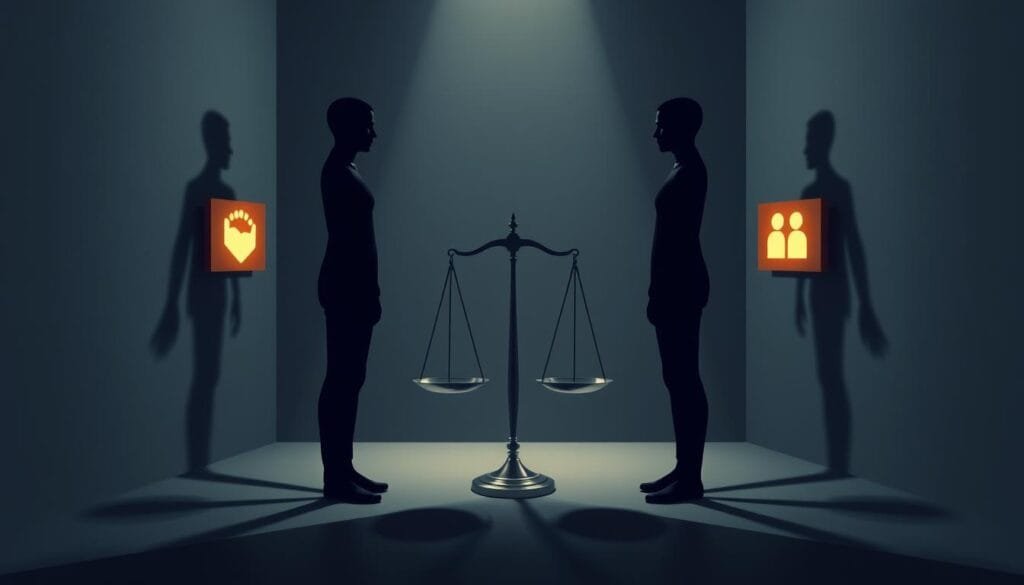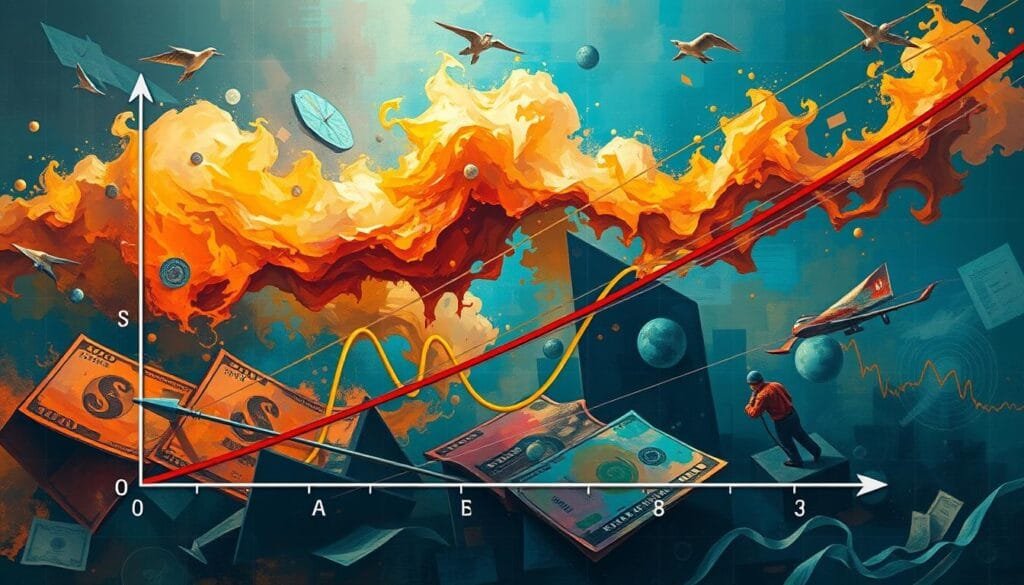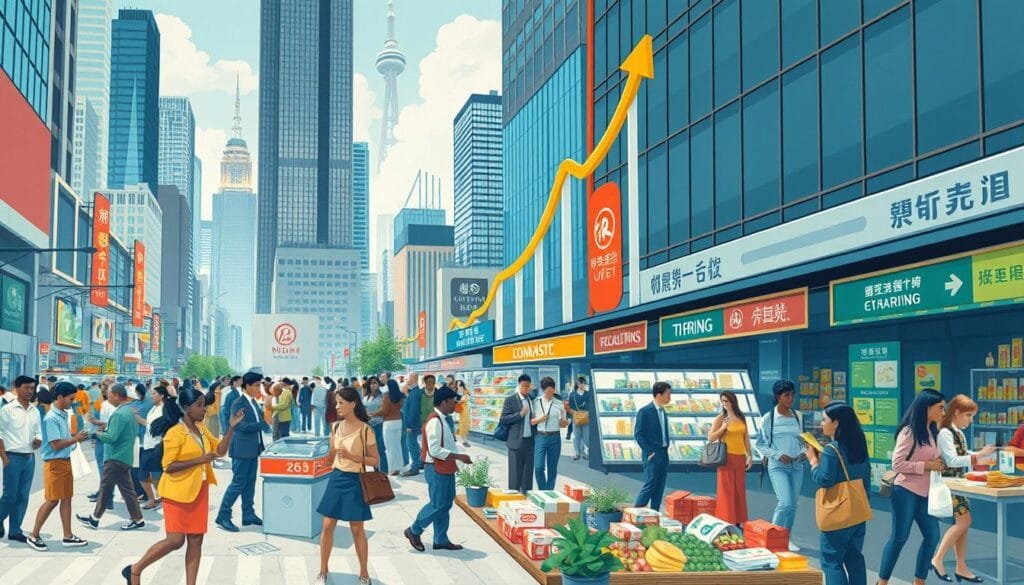Ever wondered how economic theories help solve real-world problems? They turn abstract ideas into strategic actions. This impacts everything from public policy to community growth. Economic problem-solving skills reach far beyond textbook pages.
Economics shows us how with careful analysis and making smart choices. The Cobb-Douglas function, started from 1928 US data, proves this. It shows how we can predict growth and productivity. These ideas help us use our resources and make better choices every day.
Economic problem-solving deals with resource scarcity against endless wants. This not only boosts economic efficiency. It also leads to new ideas that improve societies. Like how South Korea bounced back with smart investments guided by the Solow model.
We learn a lot by studying economic problem-solving. It shows us the blueprint for our choices, big and small. This way, we craft solutions that work well and last long.
Key Takeaways
- Economic theories have practical applications in solving real-world problems.
- The Cobb-Douglas function helps quantify productivity and growth.
- Economic efficiency is essential for optimal resource allocation.
- The Solow model explains growth through investment in infrastructure and education.
- Economics balances scarcity with human desires, leading to innovative solutions.
- South Korea’s post-civil war recovery exemplifies the effective application of economic models.
- Understanding economics is crucial for policy-making, business, and community development.
Understanding the Basics of Economics
Economics looks at how societies use limited resources to meet endless wants. By grasping economic principles, we understand daily choices and policies better.
What is Economics?
Economics studies choices by individuals, businesses, and governments under scarcity. It uses tools like cost-benefit analysis to find the best resource use. High demand for a product like beer can raise its price. This leads producers to make more for higher profits. But too much supply can lower prices a lot.
The Principles of Scarcity and Choice
Scarce resources mean we have to choose how to use them. People try to get the most benefits for the lowest costs. But feelings often guide our choices. Ads play on this to affect our decisions. As demand goes up, so do prices, urging producers to make more.
The Role of Incentives
Incentives are key in guiding economic actions. When raw materials are scarce and costly, people use less. How companies motivate employees can also affect how much they produce. For instance, a brewery focusing on bottle numbers instead of volume might not meet goals well. Plus, bonuses might boost immediate results but hurt the business later if they don’t match long-term plans.
| Factor | Impact |
|---|---|
| High Demand | Increases Prices and Supply |
| Scarcity of Resources | Increases Costs |
| Incentive Misalignment | Decreases Efficiency |
Game Theory and the Prisoner’s Dilemma
Game theory shows us how deep and complex decisions can be in economics through the prisoner’s dilemma. This concept doesn’t just reveal individual decision-making challenges. It also shows how hard it is for society to cooperate when our interests conflict.
Exploring Strategic Decision-Making
The prisoner’s dilemma gives us a tough choice. Imagine two people who can either work together or betray each other. Their decisions lead to different consequences. If both betray, they get 5 years in jail each.
If they stay silent, they only face 1 year for lesser charges. The dilemma gets tougher if one talks and the other doesn’t. Then, the one who stays quiet gets 20 years, while the talker goes free.

What’s fascinating here is that most people choose to betray or “defect.” This choice aligns with the Nash Equilibrium. It shows how aiming for our best can sometimes lead to worse outcomes for everyone. For example, both could serve a total of just 2 years if they cooperated. But any other choice ups the total time served.
The prisoner’s dilemma isn’t just an idea. It happens in real life, like in battles between big companies. Take Coca-Cola and PepsiCo. If they both keep prices high, they could each make $500 million more. But if one drops prices, they could grab $750 million, leaving the other with losses. This move starts a price war, trimming their profits to $250 million each despite selling more.
Game theory’s big lesson is about finding ways to work together. Strategies like “tit for tat” help companies cooperate over time. Laws and policies also help by encouraging teamwork. This way, we can overcome the prisoner’s dilemma and work for the common good. By applying these lessons, we aim for a society where everyone benefits.
Production and Growth with the Cobb-Douglas Function
The Cobb-Douglas function is key in showing how outputs link to labor and capital inputs. It plays a big role in understanding how different production factors affect the economy. Charles Cobb and Paul Douglas created this formula. It’s very important for studying how economies can grow.
When we use the Cobb-Douglas formula on past data, we learn a lot about production trends. For example, it helped study U.S. manufacturing from 1899 to 1922. The findings showed labor was 75% of the output value, and capital was 25%. These results help us understand more about how inputs affect outputs.
The formula also shows how tech advances help production. It indicates that with a 1.01 estimate, tech greatly aids growth. The formula uses \(\alpha\) and \(\beta\) to show the value of labor and capital in creating products.
The formula goes \( P = aL^{\lambda}K^{1-\lambda} \). Here, \(L\) and \(K\) show how labor and capital mix to give total production (\(P\)). The mix of these inputs is always balanced. Plus, if \(\lambda\) and \(\mu\) add up close to one, it means production is steady as inputs change.
Analyzing the parameters:
- \(\lambda\), for labor, is often about 0.75.
- \(\gamma\), shows tech growth.
- \(\beta\), for capital, is usually between 0 and 1, fitting growth studies.
It’s vital to know how labor and capital work together in growth. The math behind the function points out that adding more labor or capital has smaller benefits over time. This idea is key for those planning economic policies.
Here’s a quick look at some key figures from using the Cobb-Douglas function in a model:
| Parameter | Value |
|---|---|
| Labor Exponent (\(\lambda\)) | 0.75 |
| Capital Exponent (\(\beta\)) | 0.25 |
| Efficiency Parameter (\(\gamma\)) | 1.01 |
The Cobb-Douglas function isn’t just a way to show production. It’s a complete system for looking at economic growth. This model helps us see how labor and capital work together. It guides us in understanding productivity and economic progress.
Inflation vs. Unemployment: The Phillips Curve
The Phillips Curve is key in macroeconomics. It shows how inflation and unemployment move in opposite directions. This guide helps policymakers make economic decisions and foresee future trends. It’s about finding a balance between growth and stable prices.

Graphical Representation and Analysis
The theory behind the Phillips Curve is simple. If unemployment goes up by 1%, inflation usually drops by 0.5%. This creates a curve that slopes downwards. But history, like the stagflation between 1973 and 1975, proves it’s not always accurate. Then, the U.S. saw its economy shrink for six quarters while inflation tripled.
In the 1970s, inflation and unemployment in the U.S. hit high levels. Inflation was over 10% and unemployment reached 9%. This led to an update of the Phillips Curve, introducing the NAIRU concept. It suggests a critical unemployment level of 4-5%, below which inflation speeds up.
Policy Implications and Challenges
The Phillips Curve has a big impact on economic policy. For example, cutting unemployment from 5% to 4% might make inflation jump by 1.25%. But recent trends show the curve flattening. Even with unemployment below 4%, inflation has stayed around 2%. This suggests a changing relationship.
Because of this shift, we need to rethink our economic strategies. Post-recession, inflation has been about 1.5%, even with unemployment at 3.5%. With a 2% inflation target, the Fed must stay flexible. Major policy changes can shift inflation expectations by 0.5% in a quarter, adding complexity to policy decisions.
It’s vital to grasp these trends for sound economic policy. As the world changes, the Phillips Curve stays a crucial tool for economists and policymakers.
What can economics solve?
Economics offers valuable strategies for solving complex real-world problems. It helps in reducing poverty, optimizing business operations, and improving government policies. The Bretton Woods Conference, attended by 44 nations, aimed to rebuild economies after World War II. This event showed how economics can create significant impacts through cooperation.
The Bretton Woods Conference led to the creation of the International Monetary Fund (IMF) and World Bank. These institutions focus on reducing systemic poverty and stabilizing the global financial system. Globalization, as a result, has brought prosperity and better living standards, but also increased income inequality.

Efforts by the IMF and World Bank are gradually reducing extreme poverty rates. The global pandemic has forced a rethink of economic strategies. This reflects the ongoing transformation and the power of economic solutions.
Educational programs like the Master of Science in Applied Economics show the wide use of economics. Students work together to find solutions to complex global and policy issues. They also learn about sustainability, linking it with economics.
“The increased focus on sustainability economics reflects the shift towards integrating ecological and resource limits into economic discussions.”
Economists work in various sectors, including corporate, government, and nonprofit areas. In 2022, federal government economists had an average salary of $134,776. Financial analysts, management consultants, and market research analysts had median salaries ranging between $68,230 and $96,220. This shows the wide array of job opportunities for economics graduates.
| Category | Median Salary (2022) |
|---|---|
| Financial Analysts | $96,220 |
| Management Consultants | $95,290 |
| Market Research Analysts | $68,230 |
| Policy Analysts | $63,855 (2023) |
| Federal Government Economists | $134,776 |
Economics plays a crucial role in shaping government policies, looking at statistics on issues like healthcare and education. This underscores the impact economics has on public policy. UNICEF and the Red Cross rely on economic research to help social and economic groups. This highlights the need for economics in effective decision-making.
Financial Markets and the Black-Scholes Model
The Black-Scholes model has been key in finance since 1973. Created by Fischer Black and Myron Scholes, it changed how we price options. It helps markets run smoothly and manage risk better.
Valuing Options and Derivatives
The model uses factors like strike price and stock price. It also looks at time until expiration, the risk-free rate, and asset volatility. These help figure out the price of European-style options.
Its method, introduced in a 1973 paper, uses risk-neutral pricing to adjust portfolios. This approach prices options by balancing expected returns.
The model assumes constant risk-free rate and volatility. It expects stock prices to follow specific patterns. But, it does not consider dividends or costs, and can miss market moves. Still, its simplicity made it popular for pricing options.
Impact on Market Efficiency and Risk Management
Introducing the Black-Scholes model improved market transparency and efficiency. It offered a way to price options clearly, leading to better decisions. This reduced chances for error and arbitrage.
The model uses implied volatility to reflect market conditions. But, the 1987 crash showed its limits. At-the-money options had lower implied volatilities than expected, showing a skew.
Firms have since tweaked the model to fit better with real markets. These changes cover dynamic rates, costs, and dividends. Thus, the model’s basic ideas still support global trading and risk management.
| Feature | Black-Scholes Model | Alternative Models |
|---|---|---|
| Risk-Free Rate and Volatility | Assumed constant | Dynamic adjustments in some models |
| Dividend Consideration | Not considered | Often incorporated |
| Type of Options | European-style options | American-style options in binomial/trinomial models |
| Implementation Complexity | Simpler, closed-form solution | Complex, often requiring numerical methods |
Economic Growth and Development: The Solow Model
The Solow Model provides insights into economic growth and development economics. It shows how capital, technology, and labor contribute to growth. We will look into the factors that drive economic growth and see the model in action through case studies.
Factors Influencing Economic Growth
Within the Solow Model, several factors spur economic growth, including:
- Capital Accumulation: Investing more in capital goods increases production. The equation K’ = (1–d)K + sY explains how future capital is shaped by current capital, depreciation, and investment.
- Technological Progress: Technology boosts productivity, acting as a public good. The formula Y = aF(K,L) depicts how capital and labor drive output.
- Labor Supply: Changes in labor supply affect output. According to the equation N’ = N(1+g), a 2% growth rate increases a population of 100 to 102.
Real-World Applications and Case Studies
The Solow Model helps us understand economic growth across different regions. Let’s explore some examples:
- United States: It shows strong economic growth through significant capital investment and technological advances. This demonstrates the principle I = S = sY, where savings meet investments.
- China: China’s Fast growth is a case of conditional convergence. High savings and population growth rates push quicker development compared to peers.
- India: India’s growth follows the steady-state equation (1 + g)k = (1 – d)k + sakb. This underlines how capital per worker and growth convergence forecast long-term output.
These examples highlight how savings, population growth, and tech progress affect steady-state output in various countries. This is in line with what the Solow Model predicts.
| Parameter | United States | China | India |
|---|---|---|---|
| Savings Rate (s) | 20% | 45% | 30% |
| Population Growth Rate (g) | 1.2% | 0.6% | 1.3% |
| Technological Progress (A) | High | Moderate | Variable |
Behavioral Economics: Understanding Human Decision-Making
Understanding human choices in economics isn’t just about logic. Behavioral economics blends psychology with economics to show how we really make decisions. This approach helps us see what normal economics misses by looking at emotions and thought processes.
Integrating Psychological Insights
People don’t always make choices that are best for them. They’re swayed by mental biases, limits on their reasoning, and what’s considered normal by others. The idea of loss aversion shows us that losing feels worse than winning feels good, which influences our choices greatly.
Our decisions are also affected by how we think about the chances of things happening, like overestimating the likelihood of shark attacks. It’s because of stories we hear. This explains why sometimes people make choices that don’t seem to make sense.
Two important scientists, Daniel Kahneman and Amos Tversky, have made big contributions to this field. They found that we feel losses much more than gains. This discovery is key to adding psychological understandings into how we think about economics.
Behavioral economics also looks at how things outside of us, like ads and where products are placed, make us buy more on impulse. This shows the power of choice architecture in our lives.
How information is presented can change what we decide to do. This is clear in how people save more money when savings plans are set up to do it automatically. Just a small change can make people save $600 to $1,000 more every year.
This field gives us new tools to make policies that fit better with how people really act and think. It helps improve decisions in health care, money matters, and what we buy.
In the end, including psychology in economics opens up our eyes to how we make choices. It pushes us to question old ways of thinking about economics. As we study this more, we understand better how our behaviors impact the economy.
Conclusion
We’ve seen how vital economic insights are in solving real-world issues. Economics explores areas from game theory to financial modeling. Each theory offers practical benefits, impacting society significantly. These insights help us make better choices in various fields, leading to more effective outcomes.
Economics isn’t just about numbers. It also looks at human-focused areas, like health and environmental sustainability. Specialized studies, such as Macroeconomic Theory, give a broad understanding of how economics offers solutions. This knowledge is crucial for tackling today’s challenges, from policy-making to corporate strategy.
The career potential for those who study economics is impressive. Graduates often start with high salaries and stand out in the job market. They excel in exams like the LSAT and GMAT and often move up to leadership positions. Their knowledge in areas like investment banking shows the practical value of their studies.
In closing, the economic concepts we’ve discussed show how this field can empower people and communities. By blending analytical and insightful approaches, economics improves how we handle complex issues. This leads to a better, fairer world for all of us.
FAQ
What is Economics?
A: Economics is about how people, businesses, and governments decide when they don’t have everything they need or want. It looks at how to distribute scarce resources to meet endless desires, making choices wisely to get the best results. Key ideas like supply, demand, and incentives are vital.
The Principles of Scarcity and Choice
Scarcity means we don’t have enough resources to satisfy everyone’s needs. Because of this, choosing one thing means giving up another. Economics studies these choices to maximize happiness and effectiveness with limited options.
The Role of Incentives
Incentives are key to making economic choices. They include money-based incentives like prices and salaries, and non-money rewards such as social approval. Experts use this knowledge to predict how people and groups act, affecting consumer habits and government policy.
Exploring Strategic Decision-Making
We look at strategic decision-making with game theory, emphasizing competition and cooperation. The Prisoner’s Dilemma shows why people might not work together, even when it helps them. This theory applies to economics, politics, and business.
Factors Influencing Economic Growth
The Solow Model highlights labor, capital, and technology as economic growth drivers. This model forecasts and explains growth, aiding both emerging and established markets.
Real-World Applications and Case Studies
We use the Solow Model to plot growth paths for economies. It helps us understand how investments in tech or education affect long-term growth.
Valuing Options and Derivatives
The Black-Scholes Model prices options and derivatives in financial markets. It bases estimates on current stock values, risk, volatility, and time. This tool supports investors and managers in trading decisions.
Impact on Market Efficiency and Risk Management
The Black-Scholes Model boosts market efficiency by standardizing option pricing. It’s critical for managing risks, enabling better planning against losses through precise value and strategy analysis for options and derivatives.
Graphical Representation and Analysis
The Phillips Curve maps the trade-off between inflation and unemployment. It shows that low unemployment can lead to high inflation and vice versa. This tool aids in economic prediction and analysis.
Policy Implications and Challenges
The Phillips Curve guides policymakers on inflation and unemployment balance. But real-world issues complicate this relationship. Leaders need to consider more factors and adapt their strategies to foster growth while keeping prices steady.
Integrating Psychological Insights
Behavioral economics brings psychology into economic theory, exploring how emotions and biases affect choices. It reveals why people sometimes make irrational decisions, leading to policies and strategies that resonate better with real behaviors.
